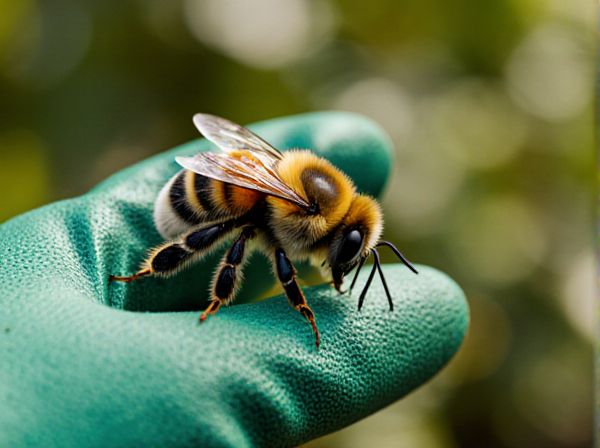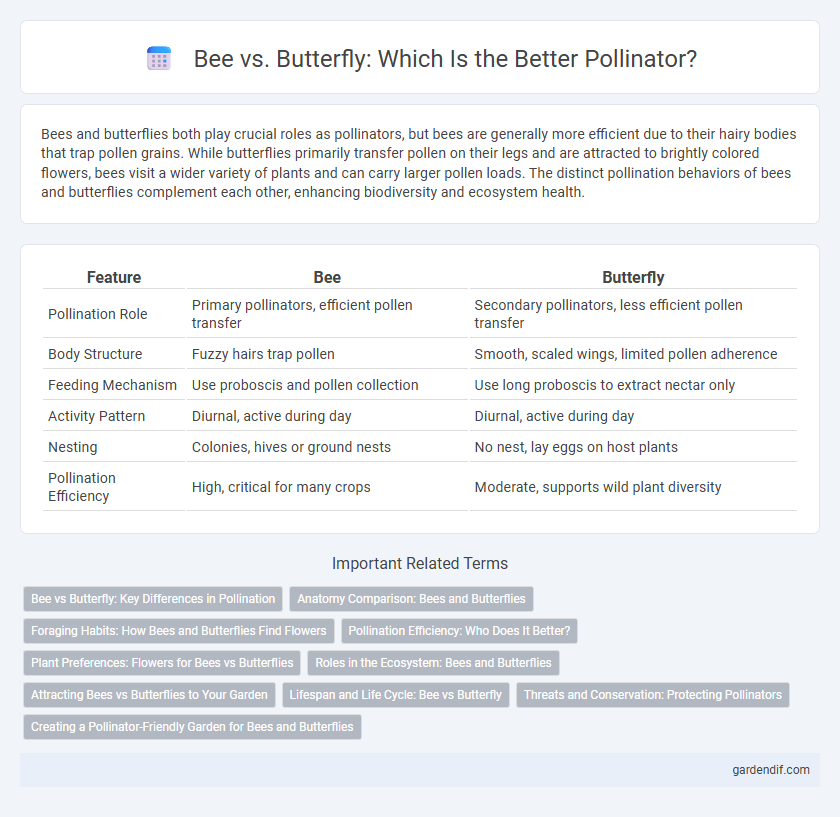
Bee vs Butterfly Illustration
Bees and butterflies both play crucial roles as pollinators, but bees are generally more efficient due to their hairy bodies that trap pollen grains. While butterflies primarily transfer pollen on their legs and are attracted to brightly colored flowers, bees visit a wider variety of plants and can carry larger pollen loads. The distinct pollination behaviors of bees and butterflies complement each other, enhancing biodiversity and ecosystem health.
Table of Comparison
| Feature | Bee | Butterfly |
|---|---|---|
| Pollination Role | Primary pollinators, efficient pollen transfer | Secondary pollinators, less efficient pollen transfer |
| Body Structure | Fuzzy hairs trap pollen | Smooth, scaled wings, limited pollen adherence |
| Feeding Mechanism | Use proboscis and pollen collection | Use long proboscis to extract nectar only |
| Activity Pattern | Diurnal, active during day | Diurnal, active during day |
| Nesting | Colonies, hives or ground nests | No nest, lay eggs on host plants |
| Pollination Efficiency | High, critical for many crops | Moderate, supports wild plant diversity |
Bee vs Butterfly: Key Differences in Pollination
Bees and butterflies serve as vital pollinators, but bees excel in pollination efficiency due to their hairy bodies that trap pollen and their behavior of visiting multiple flowers in a single foraging trip. Butterflies primarily transfer pollen on their legs and proboscis while feeding on nectar from a limited range of flowers, resulting in less effective pollen distribution. The structural adaptations of bees, such as pollen baskets on their hind legs, significantly enhance their role in cross-pollination compared to butterflies.
Anatomy Comparison: Bees and Butterflies
Bees possess hairy bodies and branched setae that enhance pollen collection, while butterflies have smooth, scaled wings adapted for flight rather than pollen transport. Bees' hind legs feature pollen baskets (corbiculae) specialized for carrying pollen, contrasting with butterflies' slender legs primarily used for landing on flowers. Antennae of bees are elbowed and clubbed, optimizing sensory functions in foraging, whereas butterfly antennae are filamentous with clubs at the end, aiding in navigation and mate detection.
Foraging Habits: How Bees and Butterflies Find Flowers
Bees rely on their keen sense of smell and vision to detect ultraviolet patterns on flowers, guiding them efficiently to nectar sources. Butterflies use a combination of color vision and the ability to sense floral scents, often preferring brightly colored flowers with landing platforms. Both pollinators exhibit distinct foraging behaviors that influence their effectiveness and the types of flowers they visit.
Pollination Efficiency: Who Does It Better?
Bees are generally more efficient pollinators than butterflies due to their physical adaptations such as branched hairs that trap pollen and their behavior of visiting multiple flowers of the same species in a single foraging trip. While butterflies contribute to pollination through their long proboscis and frequent flower visits, their lighter bodies and sporadic foraging patterns result in less pollen transfer. Studies show bees can increase crop yields by up to 30%, making them critical for agricultural pollination compared to butterflies, whose impact is more supplementary.
Plant Preferences: Flowers for Bees vs Butterflies
Bees prefer flowers with bright colors like blue, purple, and yellow, and they are attracted to flowers rich in nectar and pollen such as lavender, sunflowers, and clover. Butterflies favor flowers with red, orange, pink, and purple hues that provide landing platforms, including milkweed, zinnias, and butterfly bush. The distinct flower preferences between bees and butterflies highlight their complementary roles in pollination and ecosystem health.
Roles in the Ecosystem: Bees and Butterflies
Bees serve as primary pollinators for a wide variety of flowering plants, directly supporting agricultural crops and natural ecosystems through efficient pollen transfer. Butterflies contribute to pollination as well, particularly favoring flowers with bright colors and deep nectar sources, thus aiding plant diversity and habitat health. Both insects maintain crucial roles in sustaining biodiversity and promoting the growth of fruits, seeds, and plants in many ecosystems.
Attracting Bees vs Butterflies to Your Garden
To attract bees to your garden, plant native flowering species rich in nectar, such as lavender, coneflowers, and sunflowers, which provide vital food sources and support local ecosystems. Butterflies favor nectar-rich flowers like milkweed, butterfly bush, and lantana that offer landing platforms and continuous blooms throughout the season. Creating a diverse garden with varied flower shapes, colors, and bloom times enhances habitat suitability for both bee and butterfly populations, boosting pollination and biodiversity.
Lifespan and Life Cycle: Bee vs Butterfly
Bees generally have a lifespan ranging from a few weeks to several months, depending on the species and their role within the colony, with queen bees living up to several years. Butterflies, on the other hand, typically live from a few weeks to a couple of months, with variations based on species and environmental factors. The life cycle of bees includes egg, larva, pupa, and adult stages within a hive, whereas butterflies undergo a complete metamorphosis consisting of egg, larva (caterpillar), pupa (chrysalis), and adult stages in diverse habitats.
Threats and Conservation: Protecting Pollinators
Bees face threats from habitat loss, pesticide exposure, and climate change, leading to widespread population declines critical to pollination. Butterflies encounter habitat fragmentation, invasive species, and pollution, which disrupt their life cycles and migration patterns. Conservation efforts prioritize creating pollinator-friendly habitats, reducing chemical use, and supporting native plant growth to protect both bees and butterflies essential for ecosystem health.
Creating a Pollinator-Friendly Garden for Bees and Butterflies
Creating a pollinator-friendly garden involves planting a diverse range of native flowering plants that provide nectar and pollen throughout the growing season, catering to both bees and butterflies. Bees thrive in gardens with clusters of flowers like lavender, coneflowers, and sunflowers, while butterflies are attracted to milkweed, lantana, and butterfly bush for nectar and host plants for their larvae. Including water sources, avoiding pesticides, and providing shelter such as bee hotels and butterfly-friendly resting spots enhance habitat quality for these vital pollinators.
Bee vs Butterfly Infographic

 gardendif.com
gardendif.com